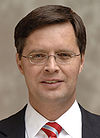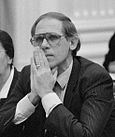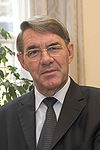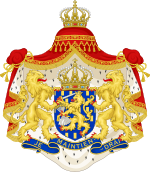- Dutch general election, 2002
-
Dutch general election, 2002 
1998 ← May 15, 2002 → 2003 All 150 seats to the House of Representatives
76 seats were needed for a majorityFirst party Second party Third party 


Leader Jan Peter Balkenende Pim Fortuyn (Assassinated) Hans Dijkstal Party CDA LPF VVD Leader since 2001 2002 1998 Last election 29 seats, 18,3% First Election 38 seats, 24,7% Seats won 43 26 24 Seat change +14 +26 -14 Popular vote 2.653.723 1.614.801 1.466.722 Percentage 27,9% 17,0% 15,5% Fourth party Fifth party Sixth party 


Leader Ad Melkert Paul Rosenmöller Jan Marijnissen Party PvdA GL SP Leader since 2001 1994 1988 Last election 45 seats, 29,0% 11 seats, 7,3% 5 seats, 3.5% Seats won 23 10 9 Seat change −22 -1 +4 Popular vote 1.436.023 660.692 560.447 Percentage 15,1% 7.0% 5,9% Seventh party Eighth party Ninth party 


Leader Thom de Graaf Kars Veling Bas van der Vlies Party D66 CU SGP Leader since 1998 2001 1986 Last election 14 seats, 9,0% 5 seats, 3,3% 3 seats, 1,8% Seats won 7 4 2 Seat change -7 -1 -1 Popular vote 484,317 240,953 163.562 Percentage 5.1% 2.5% 1,7%
Seats
Prime Minister before election
Prime Minister
The General Election to the House of Representatives of the States-General of the Netherlands was held in the Netherlands on May 15, 2002.
The election was arguably the most dramatic in Dutch history[1][2][3], not just in terms of the electoral results. It was completely overshadowed by the assassination of politician Pim Fortuyn only nine days before election day. Fortuyn's party made a huge leap from nothing to 17% of the seats, making it the second largest party. Fortuyn had especially attacked immigration policies and also questioned many aspects of government by the previous 'purple' cabinets (Paars) of Wim Kok, which he blamed for everything from crime to waiting lists in health services.
Contents
Result
The great losers of the election were Labour Party, People's Party for Freedom and Democracy and Democrats 66, the coalition parties of the 'purple' cabinets. Especially the Labour Party under the technocratic leadership of Ad Melkert suffered a landslide defeat.
The Christian Democratic Appeal was the surprising winner of the election, gaining 14 seats (from 29 to 43) and becoming the largest party in the House of Representatives. This success is in part owed to its new leader Jan Peter Balkenende, who went on to become prime minister, and to its neutral attitude in the debate with Fortuyn, not having participated in the supposed ‘demonization’ by the political Left.
Another party making its debut in the House of Representatives was Livable Netherlands.
The 15 May 2002 election was the beginning of a year of political chaos in the Netherlands following the LPF leader's assassination on 6 May the same year. The power vacuum resulted in violent internal conflicts in LPF, which eventually led to the fall of the first Balkenende cabinet (CDA-LPF-VVD), which governed from 22 July 2002 to 16 October 2002. The CDA once again became a coalition party after eight years in opposition (1994-2002) in a government which, however, became the shortest-ruling Dutch cabinet since the Second World War, lasting less than five months.
National summary
Turnout: 79.1%
Party Lijsttrekker Votes % Seats difference Christian Democratic Appeal Jan Peter Balkenende 2,653,723 27.9 43 + 14 Pim Fortuyn List Pim Fortuyn 1,614,801 17.0 26 + 26 People's Party for Freedom and Democracy Hans Dijkstal 1,466,722 15.4 24 - 14 Labour Party Ad Melkert 1,436,023 15.1 23 - 22 GreenLeft Paul Rosenmöller 660,692 7.0 10 - 1 Socialist Party Jan Marijnissen 560,447 5.9 9 + 4 Democrats 66 Thom de Graaf 484,317 5.1 7 - 7 ChristianUnion Kars Veling 240,953 2.5 4 - 1 Reformed Political Party Bas van der Vlies 163,562 1.7 2 - 1 Livable Netherlands Fred Teeven 153,055 1.6 2 + 2 Total 9,501,152 100.0 150 Only parties that won seats in parliament are shown in the above table.
Parties
- Christian Democratic Appeal (Christen-Democratisch Appèl)
- Christian Union (ChristenUnie), merger of Reformatorian Political Federation and Reformed Political Alliance
- Democrats 66 (Democraten 66)
- Green Left (GroenLinks)
- Labour Party (Partij van de Arbeid)
- Pim Fortuyn List (Lijst Pim Fortuyn)
- Livable Netherlands (Leefbaar Nederland)
- People's Party for Freedom and Democracy (Volkspartij voor Vrijheid en Democratie)
- Political Reformed Party (Staatkundig Gereformeerde Partij)
- Socialist Party (Socialistische Partij)
Further reading
- Van Holsteyn, Joop J. M.; and Galen A. Irwin (April 2003). "Never a dull moment: Pim Fortuyn and the Dutch parliamentary election of 2002". West European Politics 26 (2): 41–86. doi:10.1080/01402380512331341101.
External resources
- NSD: European Election Database - Netherlands publishes regional level election data (NUTS 1-3); allows for comparisons of election results, 1994-2010
References
- ^ Simons, Marlise (2002-05-07). ""Rightist in Netherlands Is Slain, and the Nation Is Stunned"". Nytimes.com. http://www.nytimes.com/2002/05/07/international/europe/07DUTC.html. Retrieved 2010-06-13.[dead link]
- ^ James, Barry (2002-05-07). ""Assailant shoots gay who railed against Muslim immigrants : Rightist in Dutch election is murdered"". Nytimes.com. http://www.nytimes.com/2002/05/07/news/07iht-dutch_ed3_.html. Retrieved 2010-06-13.[dead link]
- ^ Simons, Marlise (2002-05-08). ""Elections to Proceed in the Netherlands, Despite Killing"". Nytimes.com. http://www.nytimes.com/2002/05/08/world/elections-to-proceed-in-the-netherlands-despite-killing.html. Retrieved 2010-06-13.
Netherlands 
This article is part of the series:
Politics and government of
the NetherlandsConstitutionCabinetDecentralized gov'tForeign policyRelated subjects
 Elections and referendums in the Netherlands
Elections and referendums in the NetherlandsGeneral elections European elections Referendums Categories:- Elections in the Netherlands
- 2002 elections in the Netherlands
- 2002 in the Netherlands
Wikimedia Foundation. 2010.

